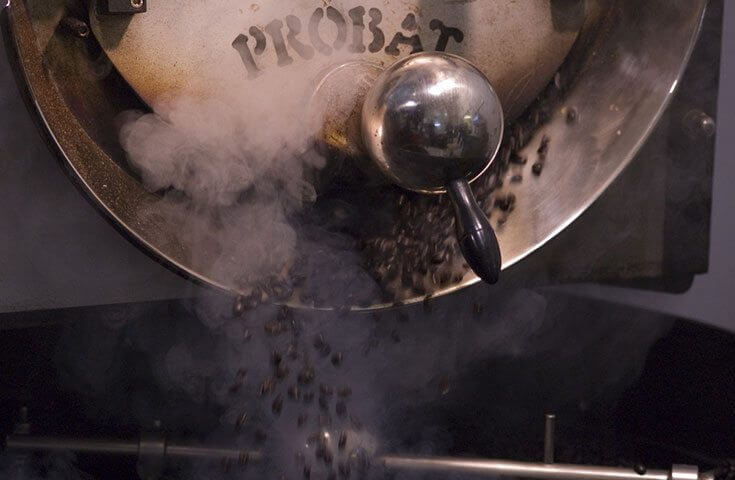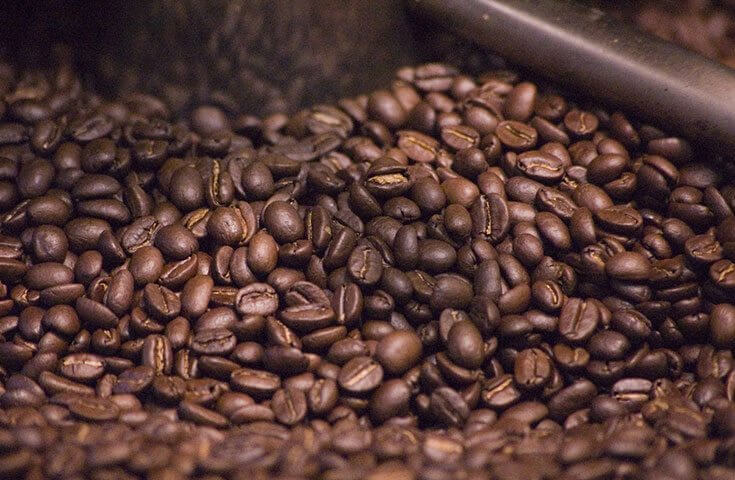Good morning, and welcome to another edition of Abe’s Coffee Column. This week, I’m going to discuss the dark art of coffee roasting.
Thinking back to last Summer, when I was walking through Covent Garden in London, I was stopped in my tracks by the aromas wafting from the open, street-level hatch of the basement below Monmouth Coffee. As I sipped my flat white out on the street, I watched as every single person that walked past stop to ‘smell the coffee’, intrigued by where it was coming from.
As well as a very smart marketing exercise, it tempted passers by in, intrigued by the shroud of mystery surrounding the coffee roasting below.
I’ve spent a fair bit of time with roasters in the past (Steve and Bill, you know who you are!). As with most art, it’s a lonely and dedicated existence. Watching how they used their finely tuned sense of taste and smell to be able to produce the best possible results made me appreciate the coffee I drink so much more.
Coffee roasters come in all shapes and sizes (the machines, and the people who use them, of course!). Increasingly, though, speciality coffee companies are roasting in small batches, to allow them to perfect the right roast for each bean, and to offer variety to their customers.
A typical small batch roaster looks something like this…
As with every stage of the journey from Arabica berry to cup, there are subtleties to coffee roasting that must be delicately balanced, and can be the difference between a great and a bad cup of office coffee. Behind every great cup of coffee, after all, is a great roaster, schooled in the secret science and creative in the dark art of coffee roasting. Each has their own techniques and way of roasting that makes their product unique.
And all of this comes from experience.
The Roasting Process
As you all probably already know, they coffee that you drink arrives at the roaster looking like this…
Coffee in its green state is undrinkable. First, its entire cellular structure must be changed.
Green coffee beans arrive at the roaster’s door dried to around 10-13%. The roaster’s job is to complete the drying process, and achieve the optimum roast for that particular bean. The beans are heated in the roaster to 250-300°C, and around a two-thirds of the way through the roasting process, visual and physical changes begin to occur – the oils expand and the cellular structure weakens.
As the exothermic heat being produced inside the bean takes over from the endothermic heat in the roaster, a distinctive cracking noise is heard – what’s called the first crack.
Now, pay attention. This is where it gets interesting. The first crack is the hinge on which the whole roast pivots. How the roaster proceeds from here determines the outcome of the roast – this is where experience, senses and profiling come into play, and the true art of the roaster is revealed.
Profiling is the controlling of variables after the first crack to determine the nature of the final roast. Too much heat, too quickly, and you can overshoot the target roasting temperature. If the roaster keeps adding heat at the same level after first crack, acidity and complexity will be accentuated in the final profile, but often to the detriment of body and sweetness. Alternatively, if the heat is removed after first crack, there’ll be less acidity, but greater body and sweetness.
Ideally, the roaster wants to find a happy medium between the two, reducing the heat after first crack and reapplying in a controlled way to produce the perfectly balanced, light roast. This is where the experience of the roaster comes into play. A lighter roast preserves their natural flavours of the bean, and often results in a chocolatey, nutty flavour over the smoky and spicy flavours of a darker roast.
So roasting is no great mystery, but it does take incredible skill, attention to detail and experience. So next time you brew a coffee at the office, pay your respects to the roasters, as they did to the growers before them.
Want to know where to get well-roasted, high-quality coffee beans? Click here.
Thanks for reading, I’ll be back in two weeks time (24th August) with another coffee column. This time, though, I’m opening it up to the readers to help choose the topic. Is there some aspect of the office coffee experience or a coffee-related subject you would like me to write about? Get in touch! Tweet @Abe_Greener, get in touch on Facebook, or leave us a comment in the section below.
We look forward to hearing from you, but in the meantime, keep striving for #betterofficecoffee!
Abe’s Coffee Column is Powered By








Thanks for the mention, Brian! I’ve been meaning to give home roasting a try, and your article has inspired me.Can you suggest a good place to get some quality green coffee beans? Really appreciate the support – especially from you, my coffee guide in any new city! You’ve helped me find some sensational coffee shops…